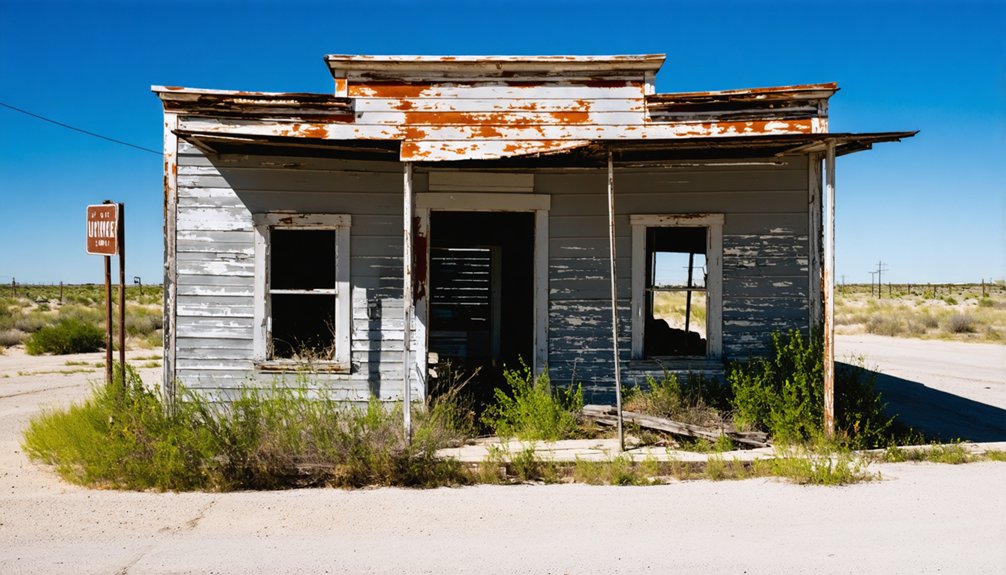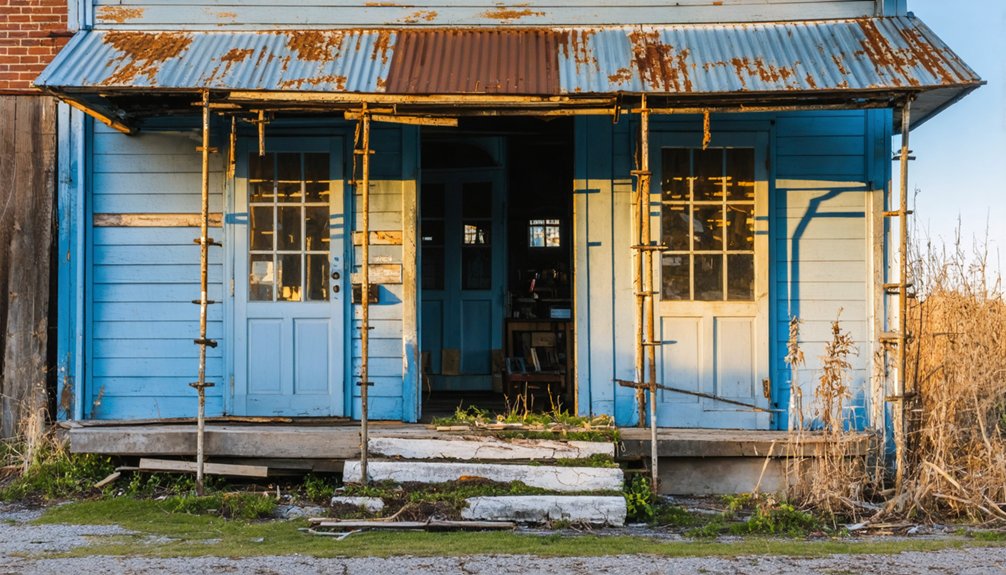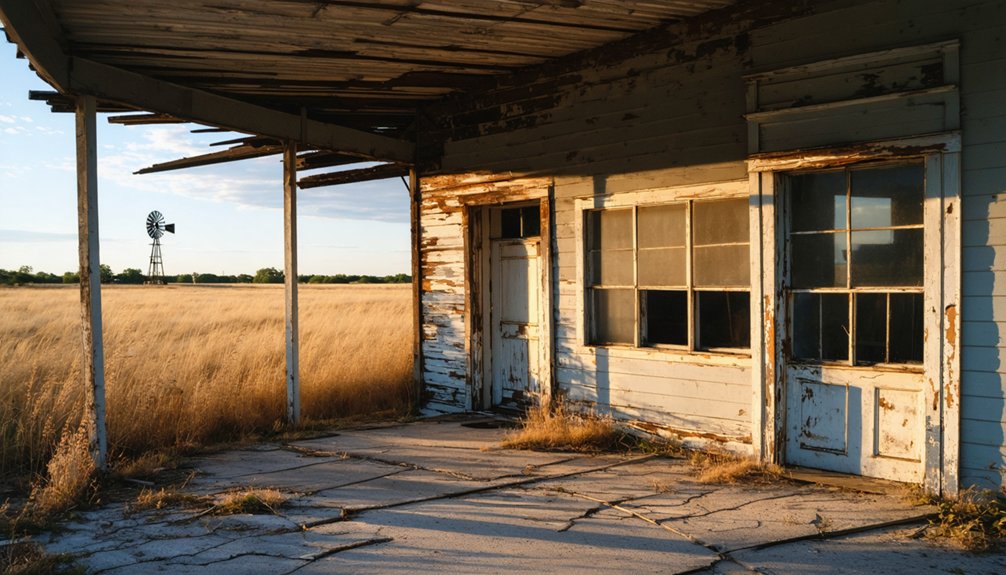You’ll find Orient, Texas near Sweetwater, where it emerged in 1900 as a promising railroad town along the Kansas City, Mexico and Orient Railway. The town flourished briefly through agriculture and mining activities, maintaining a small but resilient population of 10-40 residents centered around its general store and railway station. After the railroad’s rerouting in the early 1900s, Orient declined into a ghost town, though its scattered foundations and rugged canyon terrain hold fascinating stories of boom-and-bust ambitions.
Key Takeaways
- Orient emerged in 1900 alongside the Kansas City, Mexico and Orient Railway project, designed to connect Kansas City with Topolobampo, Mexico.
- The town maintained a small population of 10-40 residents, centered around railroad operations, farming, and local mining activities.
- Economic decline began when the railroad bypassed the settlement, leading to closure of the post office and general store.
- Historic remnants include concrete foundations, railway station ruins, and the KCM&O roundhouse remains scattered throughout the site.
- Visitors can explore the ghost town from April through October for $12-$15, viewing scattered ruins in rugged canyon terrain.
The Birth of a Railroad Town
When Arthur Edward Stilwell envisioned the Kansas City, Mexico and Orient Railway in 1900, he set in motion an ambitious plan to connect Kansas City with Mexico’s Pacific port of Topolobampo.
The railroad expansion through Texas sparked new opportunities for town planning and development, particularly in regions like Sweetwater and San Angelo. With a GDP of $169.5 billion, Kansas City’s economic influence drove much of the railway’s initial planning and investment. Construction began as crews laid tracks near Sweetwater, Texas in 1900.
You’ll find that communities along the proposed route enthusiastically supported the construction with liberal donations, recognizing the potential for economic growth and improved market access.
Daily Life in Early Orient
As settlers established their routines in early Orient, the town’s daily life centered around essential community structures and agricultural activities.
You’d find farmers and ranchers starting their days early, heading to their fields or tending to livestock in the stock-pens. The general store served as your primary hub for supplies, news, and community gatherings, while the blacksmith kept your essential tools in working order.
Daily routines revolved around the railroad’s schedule, with many of your neighbors working on the railway. The cotton gin buzzed with activity during harvest season, processing crops from local fields. The town maintained a steady population of 10-40 throughout its active years.
Life in Orient flowed with the rhythm of passing trains and the seasonal hum of cotton gins at harvest time.
You’d rely heavily on fellow residents for support, whether you needed help with farming tasks or organizing social events. The Kansas City, Mexico and Orient Railway Company established the town in 1908, bringing new opportunities for trade and commerce. The post office kept you connected to the outside world, while the local businesses sustained your community’s basic needs.
Economic Growth and Development
Like many Texas ghost towns, Orient’s economic trajectory was shaped by the dual forces of railroad access and mineral extraction during its early development phase.
You’ll find that the town’s growth accelerated as mining operations expanded, with coal serving as the primary resource driving both employment and commercial activity.
The railroad’s presence amplified Orient’s economic potential by connecting its coal production to broader markets, though this prosperity would prove temporary as the town followed the boom-bust pattern typical of resource-dependent communities.
Similar to the Mariscal Quicksilver Mine, which operated in the early 1900s and employed Mexican citizens, Orient’s mining operations relied heavily on immigrant labor.
The town experienced the same fate as Helena when railroad rerouting led to its eventual decline and abandonment.
Railroad Trade Impact
Through its ambitious network expansion, the Kansas City, Mexico and Orient Railway transformed regional commerce and development across Texas between 1900-1928.
You’ll find that this railroad expansion created essential trade corridors linking previously isolated communities to broader markets, fundamentally reshaping the region’s economic landscape.
The railway’s impact on economic integration was particularly evident in towns like Sweetwater, San Angelo, and Alpine, where you’d see property values climb and local industries flourish. The significant growth mirrored broader state trends, as Texas reached 17,078 miles of total railroad track by 1932.
The rail network markedly reduced transportation costs, allowing businesses to reach distant markets more efficiently.
You’ll notice how the railway’s presence became especially critical for West Texas oil field development, creating jobs and stimulating manufacturing and agricultural growth.
Despite financial challenges and political disruptions, the Orient Railway established lasting trade connections that shaped Texas’s commercial destiny.
Construction began in Sweetwater in 1904 and steadily progressed to connect major economic hubs across the region.
Mining Resource Boom
The mining industry emerged as another powerful force in Orient’s economic landscape, complementing the railroad’s influence on regional development.
You’ll find that mining techniques evolved considerably throughout Texas’s history, from early Spanish colonial ventures to the mid-20th century uranium boom. The historical impact of these mineral discoveries reshaped Orient’s economic trajectory, as the region benefited from various mining rushes – from silver extraction in the Trans-Pecos area to coal mining operations that supported industrial growth. Mining operations required extensive manual labor and tools, reflecting the challenging nature of early extraction methods.
By the 1950s, uranium mining west of Deweesville demonstrated the continuing significance of mineral extraction, with new processing facilities capable of handling 200 tons daily.
This diversification of mining resources, coupled with government contracts through the Atomic Energy Commission, helped sustain Orient’s economic dynamism during this transformative period.
The Railroad’s Influence
When construction of the Kansas City, Mexico and Orient Railway began near Sweetwater in 1900, it marked the beginning of a transformative era for West Texas communities.
A significant milestone was reached when the line extended to the Pease River by 1908, establishing vital connections across the region.
You’ll find that this railroad expansion brought unprecedented economic opportunities to previously isolated regions, connecting towns like San Angelo and Alpine to crucial markets across Texas and beyond.
The railway’s influence wasn’t limited to transportation alone. As you explore the history of West Texas, you’ll discover how the KCMO created lasting economic impact through its support of the developing oil fields in the 1920s.
Despite facing financial challenges, including bankruptcy in 1912, the railroad persevered, continuing to serve as a lifeline for rural communities until its acquisition by the Santa Fe Railway in 1928, forever changing the landscape of West Texas commerce and settlement.
Notable Buildings and Landmarks

You’ll discover the historic railroad station‘s stone foundation and weathered platform that once served as Orient’s essential transportation hub.
Walking down Main Street, you can observe the skeletal remains of several general stores with their original wooden facades still partially intact.
The town’s spiritual center is marked by the exposed concrete foundation of the old church, where only scattered limestone blocks hint at its former architectural grandeur.
Historic Train Station Ruins
Remnants of a once-bustling Kansas City, Mexico & Orient Railway (KCM&O) station stand as silent witnesses to Orient’s railroad heritage. You’ll find these ruins southeast of San Angelo, where they mark a significant chapter in Texas railroad history.
Unlike San Angelo’s grander Spanish-style depot, this station featured a more utilitarian train station architecture, serving as an essential link in the Orient Line’s operations until Santa Fe Railroad’s acquisition in 1928.
Near the station site, you can spot remnants of the KCM&O roundhouse, where rail maintenance once kept the lines running smoothly.
The tracks west of the site now end beyond W. 19th Street, a reflection of the route that once stretched toward Sterling City. While not preserved like San Angelo’s museum depot, these ruins offer a raw glimpse into the region’s railroad history.
Main Street Store Remains
The crumbling walls of Orient’s Main Street Store stand as a testimony to the town’s former commercial significance. As the town’s economic hub, this classic early 20th-century mercantile building facilitated essential trade between local farmers and ranchers.
You’ll find architectural features typical of rural Texas, including remnants of wooden frame construction and traces of a once-welcoming front porch.
- Navigate through overgrown paths to discover collapsed roof sections and weathered foundation stones
- Examine scattered debris of broken glass and metal fragments, revealing daily commercial life
- Picture the store’s decline factors: railroad bypass, agricultural mechanization, and population exodus
- Consider the site’s cultural significance and archaeological potential for understanding rural Texas commerce
The store’s deteriorating remains offer a compelling window into Orient’s pioneering spirit and eventual abandonment.
Old Church Foundation Site
Sacred ground remains where Orient’s church once stood, marked by a weathered 20-by-40-foot rectangular foundation that outlines the former house of worship.
You’ll find traces of concrete and stone masonry that once supported this essential community hub, with visible footings revealing where doorways and interior walls once divided the space.
The church history here runs deep, as this spot served not just for religious services but as the heart of Orient’s social life.
You’ll be walking the same ground where countless weddings, funerals, and town gatherings took place in the early 20th century.
Today, this silent foundation stands as a poignant community legacy, surrounded by encroaching vegetation and scattered building materials – one of the few physical reminders of Orient’s once-thriving population.
The Decline Years

During the early 1900s, Orient’s decline accelerated due to a convergence of devastating factors that reshaped the town’s destiny. The primary decline factors stemmed from significant economic shifts when the Kansas City, Mexico and Orient Railway bypassed the settlement, severing its crucial transportation lifeline.
You’ll find that this bypass triggered a cascade of closures that stripped away the town’s commercial foundation.
- The post office and general store shuttered their doors, disconnecting Orient from regional commerce.
- Local businesses dependent on railroad traffic couldn’t sustain operations.
- Population dwindled as residents sought opportunities in larger urban centers.
- Essential services disappeared, making daily life increasingly unsustainable.
Without its railroad connection, Orient couldn’t maintain its economic viability, leading to a swift transformation from a bustling community into a ghost town.
Natural Resources and Industry
Mining operations in Orient reveal a complex historical misidentification, as the significant iron ore extraction actually occurred in Orient, Colorado, not Texas. The site’s mining legacy began in 1870 when prospectors discovered substantial iron ore deposits, leading to the establishment of one of the nation’s largest iron mines.
You’ll find the area’s industrial transformation marked by Colorado Fuel & Iron‘s extensive development, including the creation of both Old and New Orient company towns. The mining operations supported up to 400 residents during peak production years, with railroad infrastructure arriving in 1881 to facilitate ore transport.
The most dramatic ecological transformation occurred through a major cave-in that created the “Glory Hole,” which now serves as a summer habitat for 250,000 Brazilian free-tailed bats, making the abandoned mine site an important wildlife sanctuary.
Preservation Efforts Today

You’ll find Orient’s key historic sites under protective measures through initiatives supported by Preservation Texas and the Texas Historical Commission’s statewide programs.
The community museum initiative, while facing historically low attendance, benefits from educational outreach programs that bring school groups to learn about Orient’s cultural heritage.
Through coordinated efforts between local heritage societies and preservation nonprofits, Orient’s remaining structures serve as tangible connections to its mining past, enhanced by interpretive displays and informational materials.
Historical Sites Protection
As preservationists face mounting challenges in protecting Orient’s historical legacy, several organizations and initiatives have emerged to safeguard the town’s remaining structures and artifacts.
Historic preservation efforts are strengthened through legal protections and community engagement, though you’ll find that funding limitations often impact the scope of site protection measures.
- You can participate in community workshops and events organized by Preservation Texas to support local conservation efforts.
- Your heritage tourism visits contribute to the economic sustainability of preservation projects.
- You’ll notice modern accommodations being thoughtfully integrated to enhance site protection without compromising historical authenticity.
- You’re able to access digital preservation records that document Orient’s historical significance, though physical site access may be limited.
These protective measures help guarantee Orient’s historical structures and cultural heritage remain intact for future generations to experience and study.
Community Museum Initiative
The West of the Pecos Museum stands as the cornerstone of Orient’s modern preservation efforts, occupying the restored 1904 Orient Hotel building and showcasing the region’s rich cultural heritage.
You’ll find carefully curated exhibits featuring pioneer artifacts, ranching memorabilia, and displays highlighting African-American and Mexican-American contributions to the area’s development.
Through community engagement initiatives, local volunteers lead tours and organize educational programs that connect you with the region’s past.
The museum’s heritage tourism impact extends beyond its walls to outdoor exhibits in Centennial Park, where you can explore recreated historic buildings.
Special events and workshops guarantee the preservation of Orient’s history while fostering community pride.
The museum’s success in attracting worldwide visitors demonstrates how local dedication to preservation can transform a historic site into a vibrant educational center.
Stories From Former Residents
Former residents of Orient have shared compelling accounts of life in this once-vibrant Texas community through oral histories preserved by the Tom Green County Historical Preservation League.
Their personal anecdotes paint a picture of a tight-knit farming and ranching society where neighbors relied on each other for support and survival.
Community memories reveal the town’s evolution from its railroad origins to its gradual decline.
- You’ll hear tales of farmers gathering at the cotton gin during harvest season, sharing news and celebrating successful yields.
- Stories describe the general store as the heart of social life, where residents traded goods and discussed local affairs.
- Accounts detail the challenging change after the railroad bypass of 1911 changed the town’s fortunes.
- Narratives reflect the resilience of residents who adapted to economic shifts until the 1970s.
Exploring the Ghost Town Ruins
Located near Villa Grove in Saguache County, Colorado, Orient’s ghost town ruins offer visitors a fascinating glimpse into Colorado’s mining heritage through a network of historic sites and geological features.
You’ll discover these remnants via a 2-mile hiking adventure starting at Valley View Hot Springs, where ghostly encounters with the past begin at both Old and New Orient town sites.
As you explore, you’ll encounter the impressive “Glory Hole,” a massive cave-in that’s now home to 250,000 Brazilian free-tailed bats during summer months.
While no intact buildings remain, you’ll find stone foundations and concrete remnants scattered throughout the rugged canyon terrain.
The $12-$15 admission grants you access from April through October, though year-round visits are possible depending on conditions.
Frequently Asked Questions
Were There Any Notable Crimes or Outlaws Associated With Orient?
While you might expect Wild West drama, historical records don’t show any notorious outlaws or significant crime history in Orient. You’ll find its decline was linked to railroad changes, not outlaw activity.
What Native American Tribes Originally Inhabited the Orient Area?
You’ll find the Coahuiltecan Indians were Orient’s original inhabitants, followed by Lipan Apache settlements. Later, Comanche culture and Kiowa heritage shaped the region through territorial expansion and nomadic movements.
Did Orient Have Its Own Newspaper or Postal Service?
Like a lone desert flower, Orient’s postal service bloomed in 1909, serving your ancestors along essential postal routes, but you’d find no trace of a local newspaper in the town’s history.
Were There Any Significant Epidemics or Health Crises in Orient?
You won’t find documented evidence of significant epidemics or health crises specific to Orient. Available health records don’t show epidemic impact, though the town’s isolation may have limited both outbreaks and documentation.
Did Orient Participate in Any Civil War or Military Activities?
You won’t find direct evidence of Civil War battles in Orient, though the area had some military presence through frontier defense units and cavalry regiments protecting against Indian raids in 1862-1865.
References
- https://adventuresofthecrazytrain.com/2014/12/04/the-town-of-medicine-mound-texas-population-0/
- https://www.timesrecordnews.com/story/entertainment/arts/2016/09/05/museum-monday-museum-tells-story-of-texas-ghost-town/92634188/
- https://www.youtube.com/watch?v=phjUE19A8HM
- https://www.southernthing.com/ruins-in-texas-2640914879.html
- https://en.wikipedia.org/wiki/List_of_ghost_towns_in_Texas
- https://texasbob.com/travel/tbt_stiles.html
- https://www.tshaonline.org/handbook/entries/orient-tx
- https://www.texasescapes.com/TexasTowns/Orient-Texas.htm
- https://en.wikipedia.org/wiki/Kansas_City
- https://www.okhistory.org/publications/enc/entry?entry=KA004



